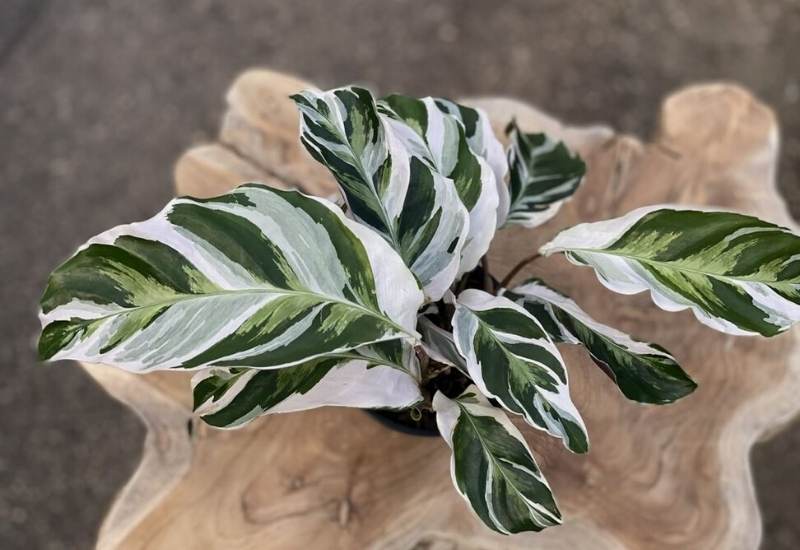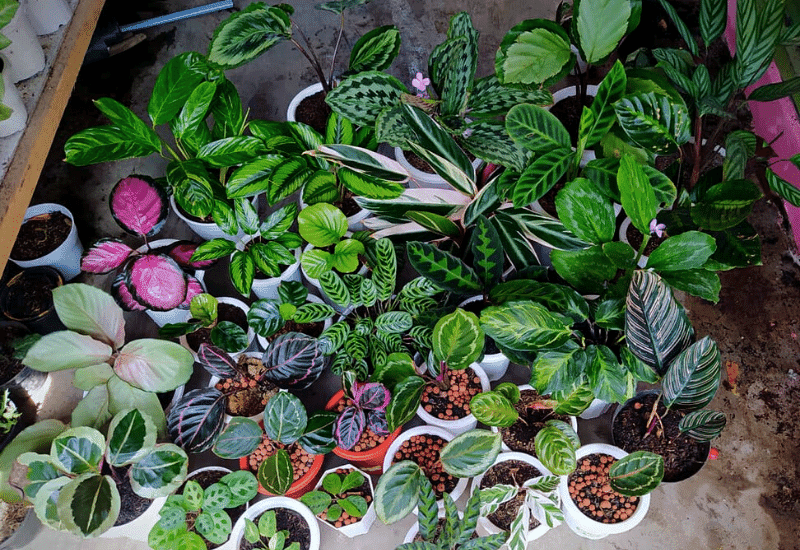
Calathea, or prayer plant, has become a loved and popular ornate foliage houseplant; its wavy, ribbed, round, pointed or oval leaves with rich and decorative variegation and patterns are a real miracle of Nature.
Depending on the variety, their leaves come in various shades of green with sometimes a hint of purple, and with stripe patterns, flames or just a colored rim. Some varieties also have orange flowers.
A native of the tropical Americas, Calathea is a herbaceous evergreen perennial plant in the family Marantaceae (arrowroot family and the prayer-plant family) which includes 60 currently known species after being reclassified into the Goeppertia genus.
While some Calathea varieties often have a reputation for being hard to please, there are lots of easy-to-care-for types known to be resilient in shady places in your house or even in the humidity of a bathroom, sheltered from the sun.
So in this illustrative guide, we will dive into the world of stunning types of Calatheas that will make an excellent addition to your indoor garden, along with tips on caring for most varieties of prayer plants.
But first of all, let’s get to know our Calathea, a tropical beauty like no other.
Calathea Overview
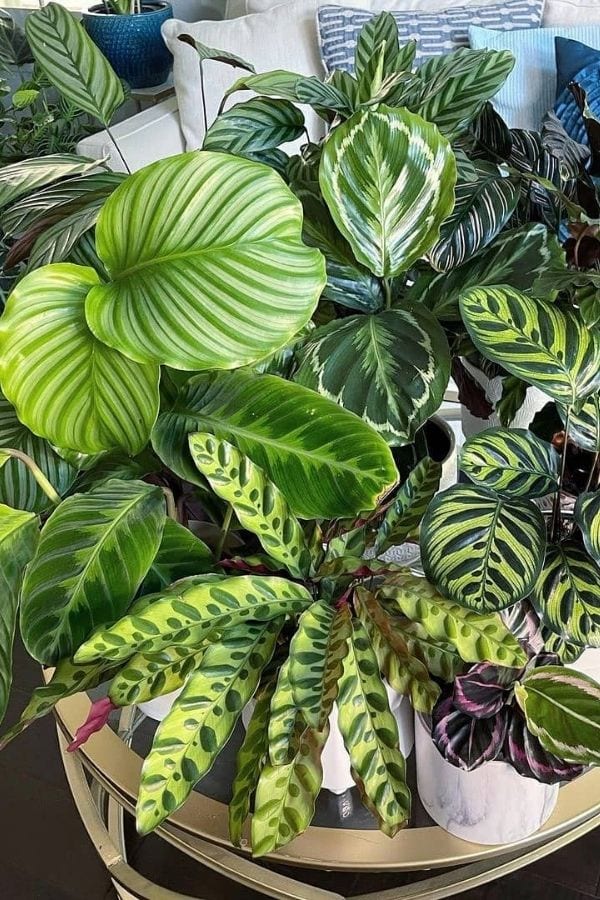
Calathea is a genus of plants coming from the jungles of the Amazon River in South America. For this reason, they retain the tropical look we expect in tropical plants. They grow well under the thick canopies of trees in the underbrush and are fairly small plants suitable for indoor growing.
Also known as “prayer plants”, this name comes to the fact that many varieties curl up or close their leaves at night. Naturally, they also love humid and sheltered places where their leaves can show off their beauty.
Prayer plants have a wide palette, with shades of pink, orange, red, and white, as well as a great range of greens, from pale to dark. In their natural environment, the leaves also shelter lots of invertebrates and small fauna, as when they are young, they collect pools of water called phytotelmata.
The inflorescences are spikes of colorful flowers attached directly to the stem. They are quite bright, but they can vary in length, and they look like those of ginger or its relative turmeric. This gives them a very oriental look because they are reminiscent of pagodas with many roofs.
On the other hand, the capsules that follow are inconspicuous.
For a quick reference guide, we have compiled a fact sheet for you.
Calathea Care Fact Sheet
This fact sheet will help you trace the key information about calathea, or prayer plant.
How To Care for a Calathea Plants
Prayer plants of the Calathea genus have really different foliage and blooms of many colors, but the basic care is the same for all of them, so, let’s see what you need to do to keep them happy and healthy.
Calatheas Thrive In Medium, Indirect Sunlight
Calatheas Thrive In Medium, Indirect Sunlight
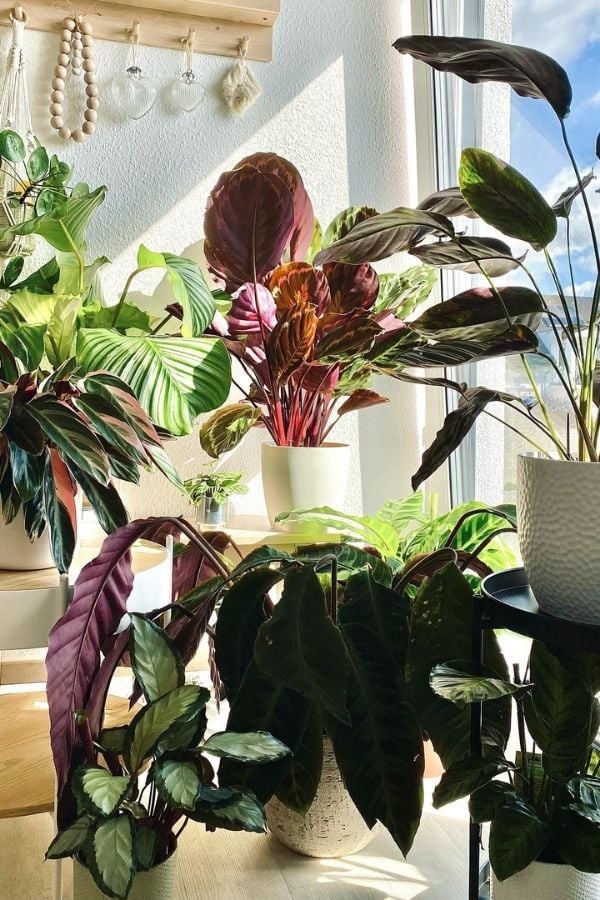
Calatheas is a low-light houseplant which will do well in medium, indirect sunlight, as they grow under the canopies of trees in their natural environment. Try avoiding too bright direct sunlight as it can scorch their tender leaves, causing them to turn white and drop.
Your prayer plant will also do well in low indirect light, but if you notice any leaf discoloring, or even unusual darkening, it means that it needs a brighter place.
It’s best to place your Calathea plants on west or east facing windows and avoid putting them on south facing ones, especially in hot and sunny months.
Keep your prayer plant about 5 to 10 feet from the window.
Calathea Needs Moist Soil Which Is Slightly Acidic
Prayer plants like well drained but moisture retentive soil. The ideal potting mix is as follows:
- 50% fertile and good quality potting soil
- 20% coconut coir
- 20% orchid bark
- 10% perlite
- A sprinkle or activated charcoal
Prayer plants do not tolerate alkaline soil; their pH range is between 5.5 and 7.0, the ideal is 6.5.
Water Your Calatheas Once A Week
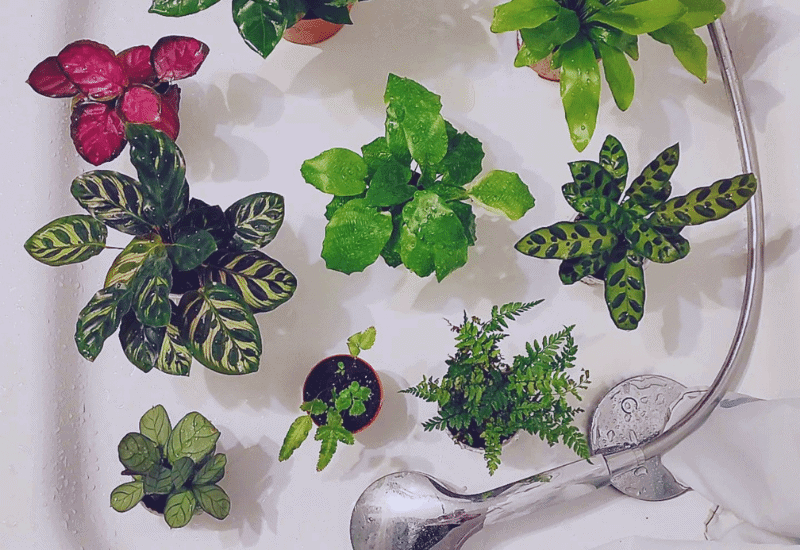
Like all rainforest plants, calatheas like constant soil humidity. This means that you should never allow the soil to dry up. At the same time, you should never get the soil soggy.
Water when the top 2 inches of soil (5.0 cm) are dry. Be generous but do not overwater. On average, this should be once a week.
Always add some water when the leaves look wilted.
Reduce slightly in winter, when the plant is dormant.
Feed Calathea plants From Mid-Spring Until Late Summer
Calathea plants like rich and fertile soil; you should feed monthly from the beginning of spring to the end of summer. You can use an organic fertilizer with NPK 10:10:10.
Be very careful not to over-fertilize your prayer plant; this fan lead to abnormal growth, loss of glossiness and even changes in coloring of the leaves, as well as missed blooming.
Calatheas Should Be Repotted Every 1-2 Years
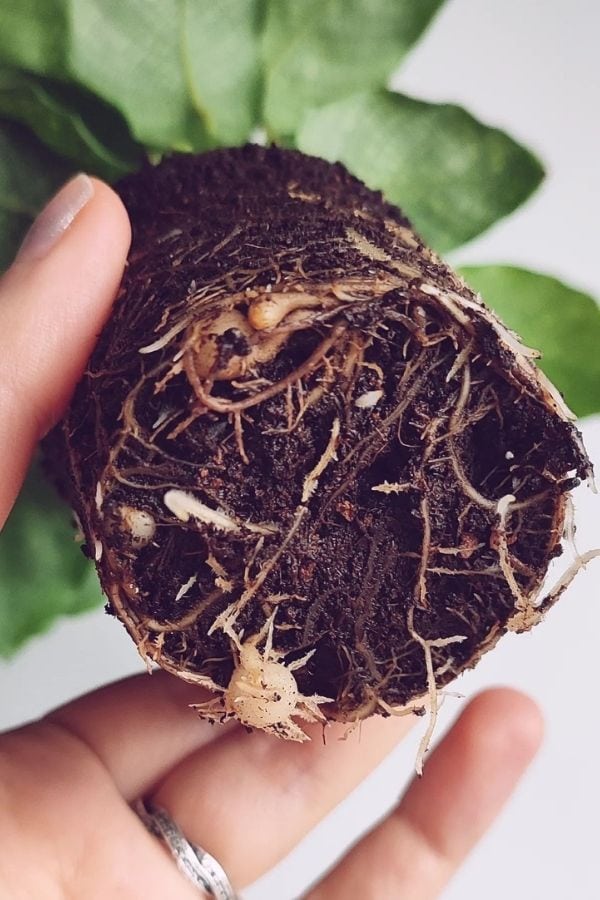
You should repot your prayer plants every year or every two years. You will need to use your judgement and see if the plant has outgrown the container. For Calathea, this is quite important because otherwise its leaf growth can be stunted.
Choose a pot which is 2 inches (5.0 cm) larger.
It is often necessary to repot calatheas after purchasing. This is because they are often sold in very small containers.
Do not repot when the prayer plant is in bloom. This may affect the flowers, and the plant is very vulnerable at this stage.
Avoid touching the rootball unless necessary; the radical system of calathea is quite delicate.
Cure and Prevent Calathea Leaf Browning, Curling, Wilting
The main concern with calathea plants is fungal infections. You will notice spots on the leaves, often brown or yellow, but not only. Whole leaves may die and rot when the problem is at advanced stage.
It is an easy problem to solve.
- Mix neem oil and water in a spray bottle, 1 to 10.
- Spray the plant abundantly.
- Make sure you spray the undersides of leaves.
Don’t worry about the neem oil going into the soil; it is perfectly safe for plants.
You can cut the ruined leaves with a sharp and sterile blade. This is not just for aesthetic reasons, it is also to prevent the spreading of the infection.
Some plants naturally drop heavily infected leaves after you spray them with neem oil. Don’t worry; it means they have appreciated the treatment and they are ready to produce new leaves.
Prune Away Dead Leaves From Your Calathea
Calatheas do not need pruning; they are small plants and they do not have branches. However, you can cut dried or sick leaves; the most important thing is that you use a sterile blade. Otherwise you risk infecting it.
In most cases, when the leaf is dry, rather than rotted, you can easily snap it off at the base.
Can You Move Your Calathea Outdoors?
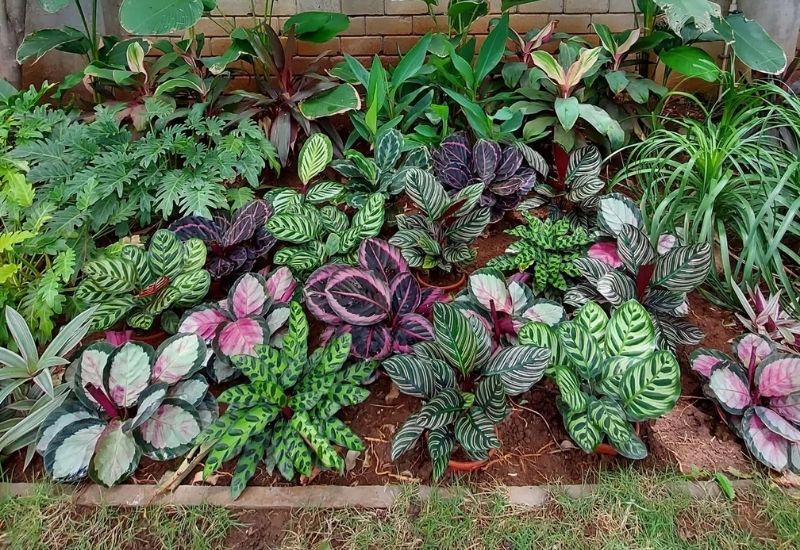
You can get your calathea some fresh air in summer, but be careful.
- Avoid sudden changes in temperature.
- Place your calathea in a sheltered place in filtered light, partial or full shade.
Be careful, at the first sing of unhappiness, like matt and non glossy leaves, take it back to its normal indoor place.
And this is all you need to do to have a lovely, decorative houseplant with amazing foliage and blooms!
16 Amazing Calathea Varieties Worth Hundreds
Here are the most beautiful yet easy to care for calatheas varieties, for filling out your houseplant collection.
1. Zebra Plant (Calathea zebrina)
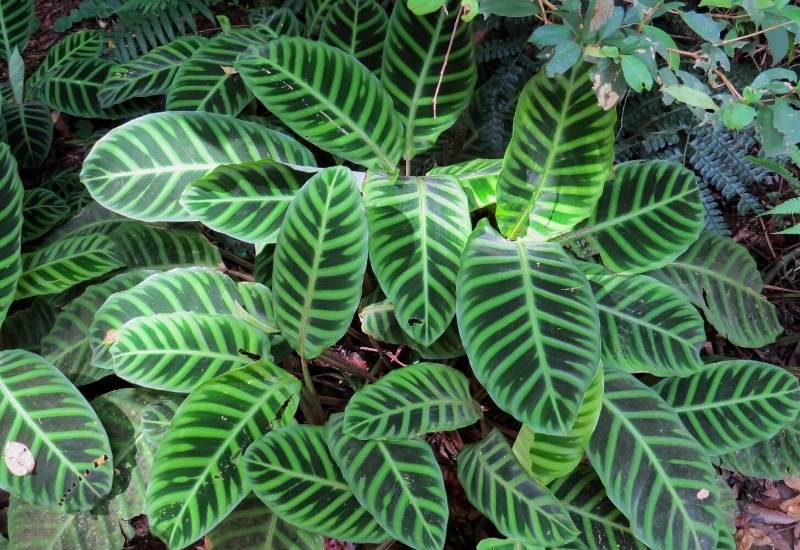
Zebra plant, a.k.a. Calathea zebrina, is one of the most popular varieties of this houseplant, and the name says it all… The leaves have contrasting diagonal dark and light green stripes that start from the midrib and end at the margins. These are matched by undulation, with the bright stripes in relief.
The texture is very original, as it feels like rubber to the touch! This makes the overall look of the plant oddly soft despite the eye-catching color display.
Each leaf is elliptical and up to 12 inches long (30 cm), with some pointing upwards and others arching to the sides.
The blooms are bright purple, short and wide; they come at the base of the plant and look like dahlias, which is somewhat unusual for prayer plants.
The Zebra plant is a classic of calatheas, ideal for the harmonic, almost neoclassical pattern on its leaves, which makes it suitable even for formal settings, like offices.
2. Rose Painted Calathea (Calathea roseopicta)
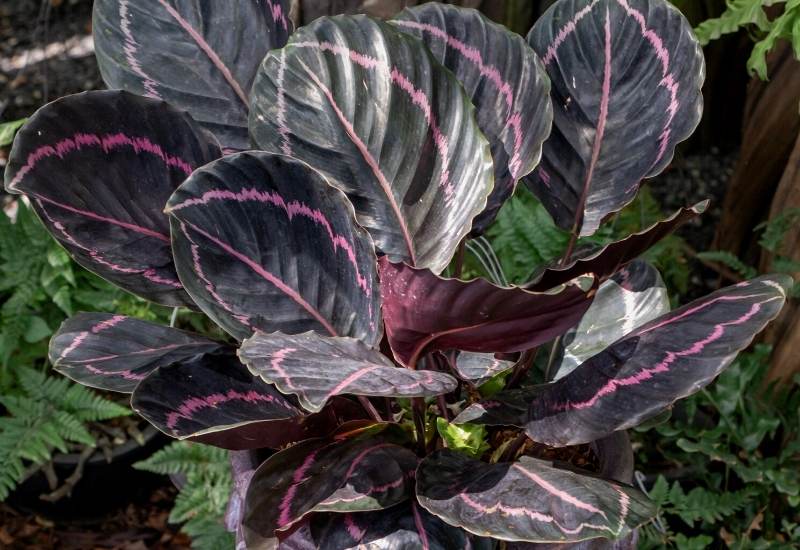
Rose painted calathea has some of the most colorful foliage of all the prayer plants in the world. Each variety has its own palette and personality, but they will have concentric areas that pick up the broad and waved shape of the leaves and use different colors.
You can find dark and bright greens, even cream and yellow, and as the name suggests, pink to purple especially on the undersides and stems.
Mind blowing varieties are the cultivars ‘Princess Jessie’ which is pink purple and almost black, with rich emerald green parts, or ‘Rosy’, with pinks and even lime or cream yellows!
The huge size of the leaves makes the display even more eye catching: up to 30 inches in length (76 cm)! The blooms are short but showy; you will find them at the base of your houseplant in shades from white to bright green, often lime.
Calathea roseopicta is the variety you want if you are after a centerpiece with an explosion of colors to brighten up your living room or office.
3. Calathea Warscewiczii (Calathea warscewiczii)
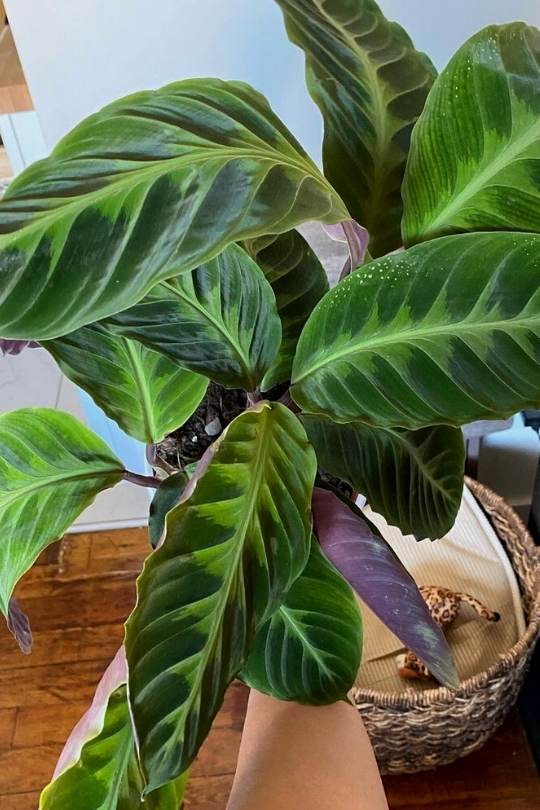
4. Peacock Plant (Calathea makoyana)
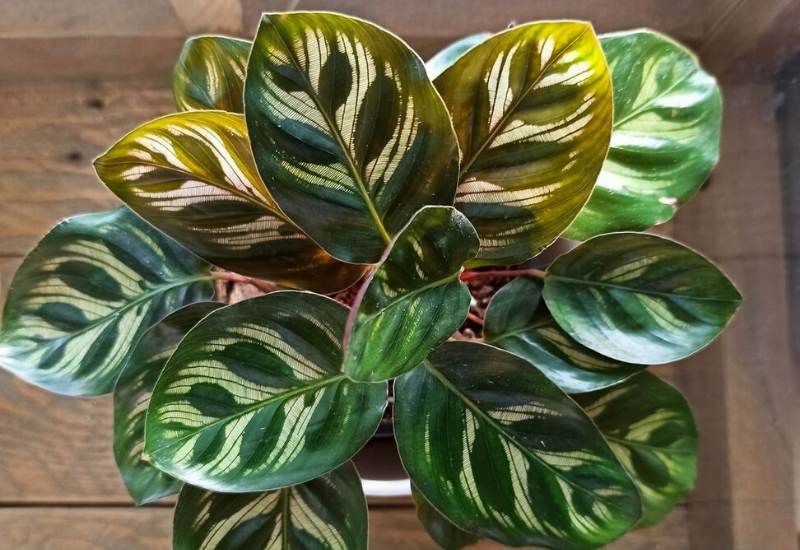
Peacock plant, or Calathea makoyana has foliage that looks like wide and broad feathers, hence the name. These are 12 inch long (30 cm) and about 8 inch wide (20 cm) egg shaped (ovate) and with an incredible pattern of cream yellow green and mid green glossy areas on the top, just like you would expect in the famous birds that give it its name.
This is then taken up on the undersides but with white and plum purple! It is really hard to decide which side is better… When they first appear, they are rolled up in pointed cones of a pink purple shade. The blooms are small and white, they appear in small clusters at the base of the plant.
Maybe the best setting for a peacock plant would be a modern and bold room, but it will look great anywhere you grow it.
5. Calathea Orbifolia (Calathea orbifolia)
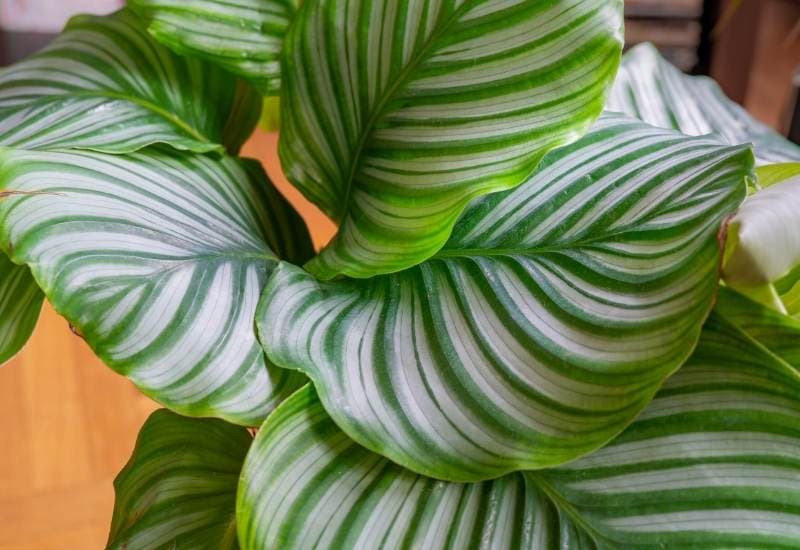
Calathea orbifolia will not strike you so much for the coloring of its foliage, but for its texture and shape. In fact the leaves of this prayer plant are mid or bright green with gentle darker stripes that run from the middle to the margins.
However, they are very glossy, deeply grooved with a midrib and plastic limes that go to the edges from it.
They are also very, very broad, in fact, they can be one foot long and wide (30 cm). They will come on short stems and create an exotic looking clump, almost like a shrub. The flowers are fairly small, short and they will appear with their cream white shade near the base of the plant.
For the tropical underbrush look, Calathea orbifolia is by far one of the best choices, and it will have a more neutral presence, which you can easily combine with other houseplants.
6. Calathea Ornata (Calathea ornata)
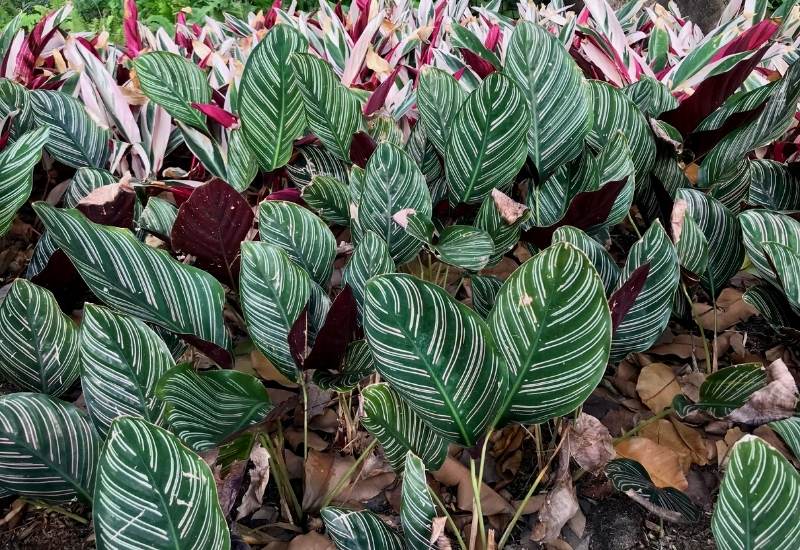
One of the most elegant varieties of this houseplant, Calathea ornata has very defined pictorial touches. This is thanks to its broad, long and pointed leaves, which are very dark green in shade, and with a glossy sheen.
This color is contrasted by groups of two to three thin white or pink stripes that curve from the mid rib to reach the margins, which they do not actually touch, leaving a frame for this modern looking natural painting.
The undersides are purple, and this adds another dimension of depth. The blooms can be bright orange, pink or white, they are very decorative and they come on long and upright stems that grow taller than the foliage itself.
Beautiful in any setting, Calathea ornata would be a magnificent presence in a modern looking, artistically inspired office or living room.
7. Eternal Flame (Calathea crocata)
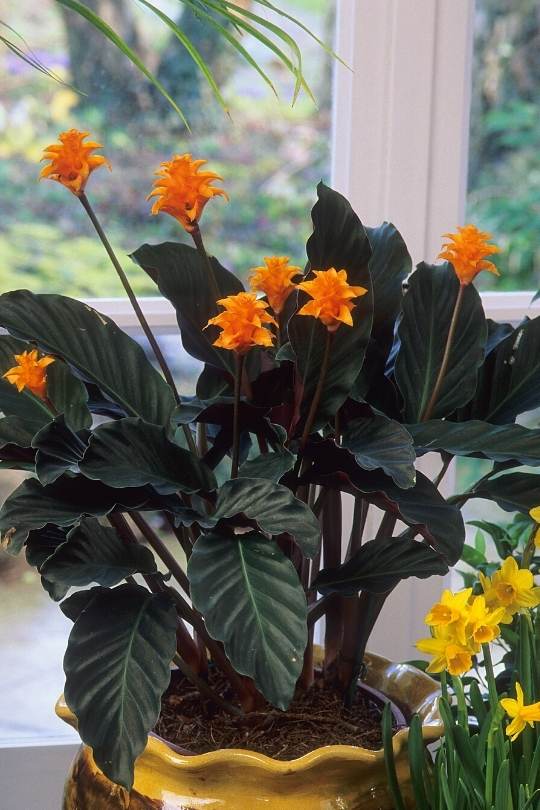
Recently introduced to the houseplant market, eternal flame, Calathea crocata is one of the best bloomers of this genus. The name of this prayer plant refers to the crocus flower, and there is a reason for this. They are bright orange or yellow and with long triangular bracts that give it an oriental look.
The actual sepals are red, and hidden within the bracts. Very much like those of turmeric, in fact, these would look great in an Asian garden. The blossoms will open on straight stems that reach up from the foliage and offer them to you above it.
What’s more, they will last for two to three months! The leaves are deep green, elliptical and pointed, with clear, soft sideways grooves and a very rubbery, almost waxy texture.
Eternal flame is becoming very popular in garden centers, its leaves are quite unusual, and the blooms are just spectacular, and this is making its fortune.
8. Rattlesnake Plant (Calathea lancifolia)
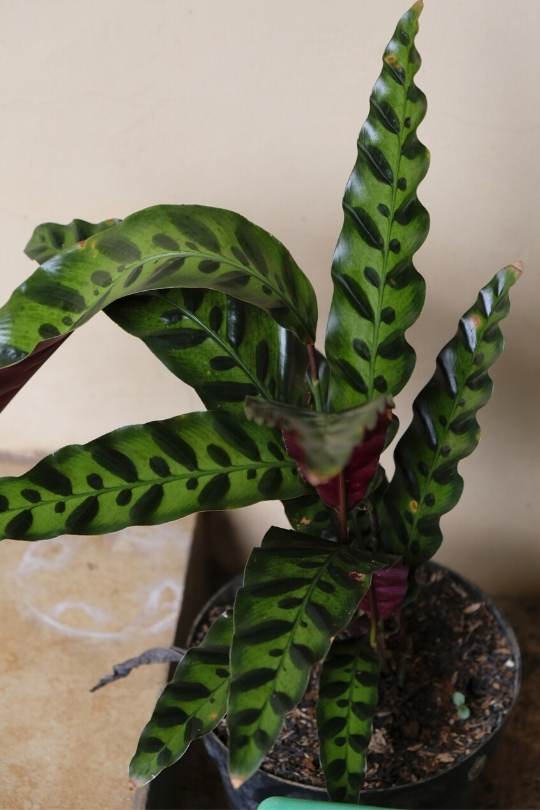
“Lance shaped” prayer plant is the meaning of Calathea lancifolia, known as rattlesnake plant, and it’s a very suitable name for this houseplant variety. Reaching 18 inches in length (45 cm), the leaves are some of the longest in this genus. They are narrow, and very pointed, which makes them look like the tips of spears.
These tend to grow upright, and they have the most amazing coloring. With a dark green stripe along the edges, they are bright green, even lime inside, but with oblong leopard spots of the same dark shade you find on the edges!
Wavy as well, these beautiful “spears” are very glossy indeed. The booms are snow white, with distinct individual heads that look a bit like butterflies at the base of the plant.
Calathea lancifolia is a show stopper for its foliage; the leaves have an African art look on them, very bold and daring in any room that needs some vibrant energy.
9. Calathea Rufibarba (Calathae rufibarba)
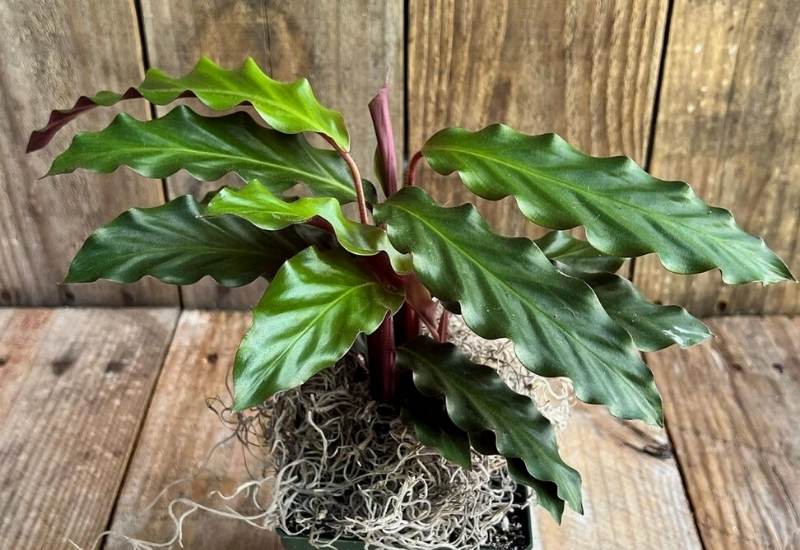
The decorative value of the Brazilian Calathea rufibarba as a houseplant comes from its very refined foliage, in both shape and color.
Very long and thin, the leaves have elegant and regular waves that run from the mid to the edges. This gives it the quality of a finely worked sculpture, which reminds me of ancient bronze age.
And copper to burgundy is the rare color you will see on the undersides, while the top of is glossy and dark green, all mounted on upright and long purple stems. The warm yellow flowers will appear at the base of the leafy clump, with bright, showy and spaced individual heads.
Pick Calathea rufibarba is you want a queen of elegance for a sophisticated room or office space, and it won’t disappoint you!
10. Calathea ‘Freddie’ (Calathea concinna ‘Freddie’)
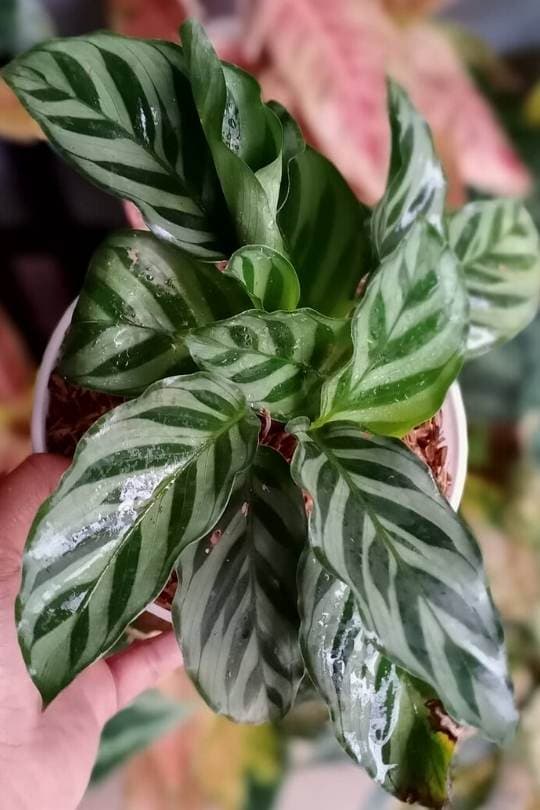
‘Freddie’ is a cultivar of Calathea concinna, a prayer plant native of Brazil, with glossy foliage that looks like big feathers. The dark and lighter bold stripes that run from the mid to the margin give it a very harmonic and regular pattern, just like you find on many birds.
The leaves are quite small compared with other species, 4 to 7 inches in length (10 to 18 inches), but they form very thick and lush clumps that bring you a slice of tropical forest to your indoor spaces.
The snow white inflorescences unfurl from short stems at the base of the plant, slowly revealing the individual sweetly scented flowers.
‘Freddy’ is a playful variety of Calathea concinna; it has a vibrant but also discreet personality, perfect for children and their indoor spaces.
11. Calathea Musaica ‘Network’ (Calathea musaica PP0005)
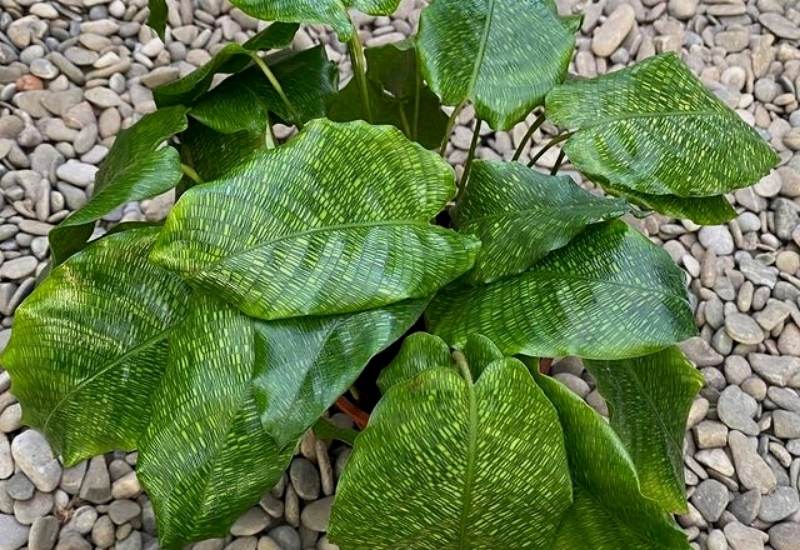
If you like delicate effects, then Calathea musaica is your houseplant. This variety does not have the bold patterns you find on other calatheas, in fact. The very glossy foliage displays a thin, geometrical pattern of tiny rectangular patches of two colors, cream yellow green and bright light emerald green.
It is a plant you want to look at close by to appreciate its full beauty, but even from a distance it has a somewhat puzzling effect with its light effects. The leaves grow on thin stems and they are broad and pointed, forming dense and florid tropical looking clumps.
The blooms are not showy, but beautiful and they will give you candid snow white inflorescences of a few heads each at the base of the plant.
Calathea musaica is perfect as a background houseplant to add texture and green foliage to larger compositions.
12. Calathea ‘Argentea’ (Calathea picturata ‘Argentea’)
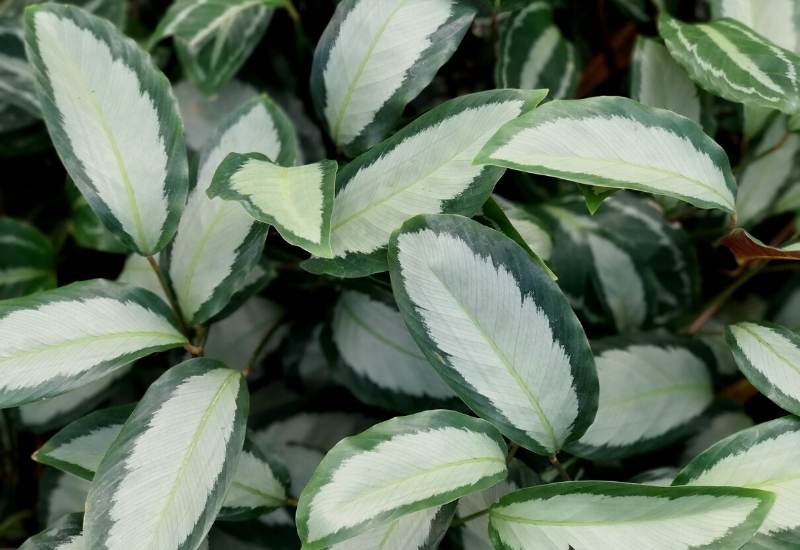
‘Argentea’ is a prayer plant cultivar of the Brazilian Calathea picturata with unique foliage. The leaves have a mid to dark green rim which surrounds a show stopping silver white/ silver green central part, which makes up most of the color ensemble.
They are ovate, about 9 inches long (23 cm) and 6 in width (15 cm), growing horizontally on thin, upright and purple petioles, a shade which is picked up on the undersides as well.
Oddly enough, the star shaped blooms occur individually on stems that bring them to the same height of the foliage itself, roughly speaking. The flowers are white with some yellow, green and pink blushes in them, they look up and very elegant indeed.
‘Argentea’ will attract attention thanks to its very individual silver coloring, beautifully framed; think about the wall shades of your room to make the best of it.
13. Calathea ‘White Fusion’ (Calathea lietzei ‘White Fusion’)
‘White Fusion’ is a prayer plant with unusually irregular patches of color, and a cultivar of the Brazilian Calathea lietzei. Unlike other varieties, the variegation is not predictable. Each leaf will have its own mix, with stripes and dashes of a palette that goes from dark green to white, often prominent, and even some purple blushes on top as well as undersides.
More similar to a modern painting than a traditional pattern, the leaves are elliptical and wavy, with pointed tips and broad shapes.
They will grow as upright cones and then unfurl and bend sideways, revealing all their magnificent tapestry. This late bloomer will also grace your rooms with showy white, purple or yellow flowers.
‘White Fusion’ is ideal for modern looking homes or offices; the rare pure white coloring is a real asset, but it will depend on lighting, so be ready to move it to a brighter place if you don’t get enough of it.
14. Calathea ‘Beauty Star’ (Calathea ornata ‘Beauty Star’)
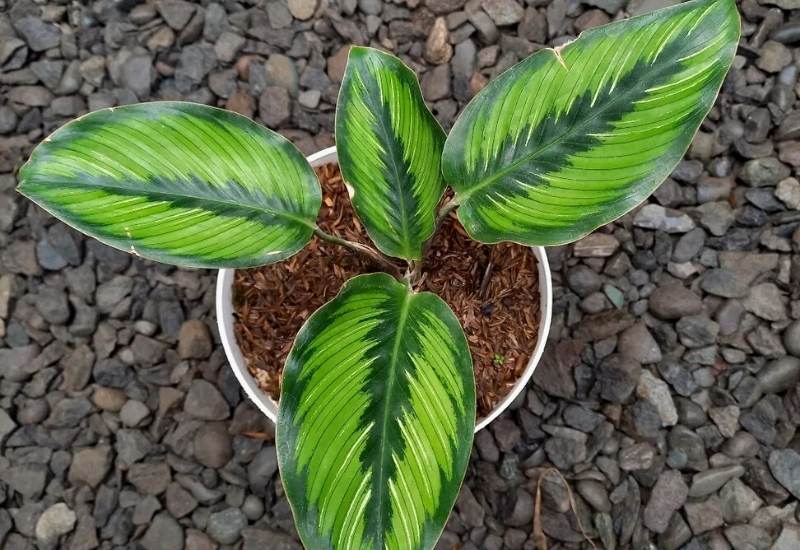
The prayer plant cultivar ‘Beauty Star’ picks up some traits of the mother species Calathea ornata and heightens its elegance. Very glossy, elliptical and pointed, the leaves can reach 1 foot in length (30 cm) and tend to form a rosette shaped clump. These are clearly grooved with arching lines that lead from the mid rib to the edge, but stop just before actually touching them.
This means that the margins are very smooth. On them, you will see gentle diagonal dashes of two shades of green, dark and bright. However, it is not a great bloomer; small and inconspicuous blossoms may appear at the base your houseplant in summer, usually orange.
‘Beauty Star’ is a classical looking variety of prayer plant, and it suits best more formal, traditional rooms, both at home or at work.
15. Medallion Prayer Plant (Calathea veitchiana)
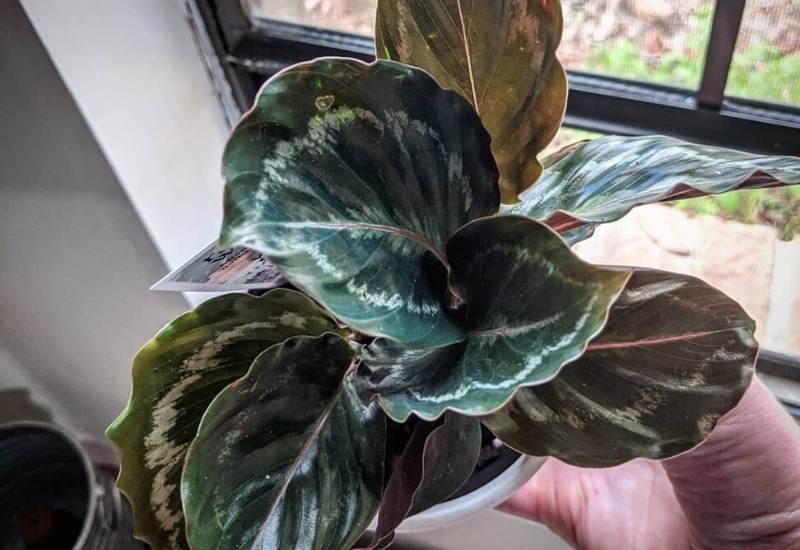
Medallion prayer plant, or Calathea veitchiana, is a the houseplant you want as a work of art in your living room. Its broad, slightly pointed and glossy foliage has made it popular all over the world. Each leaf can be one foot long and almost of the same width (30 cm), but what will amaze you is the pattern you will see on them.
Hard to describe, the series of concentric and feather like stripes of greens that range from almost black to nearly white is a show stopper, especially if you keep them clean and shiny.
The undersides are reddish to purple, as are the petioles. The flowers are small, of a delicate lavender color and they appear among much bigger, bright green bracts.
Medallion prayer plant is one of the most decorative houseplants you can have; it could replace a modern painting with its incredible leaves – this is the plant you want to wow your friends and guests!
16. Calathea Albertii (Calathea albertii)
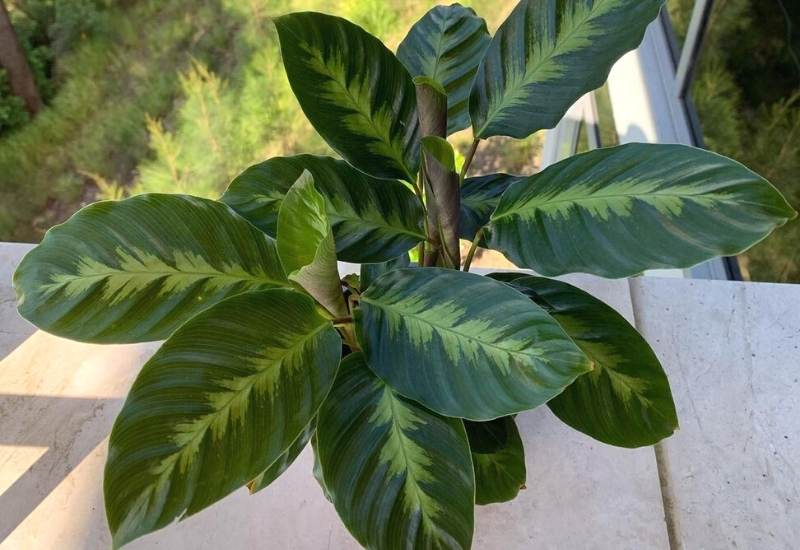
Also known as emerald feather prayer plant, has its own original look, quite distinctive from other varieties, and it may be the one that does for you. The leaves are glossy, long, up to 6 inches long (15 cm) and half as wide, wavy and pointed, but they also tend to curve to one side.
They present stripe, patches and dashes of many shades of green usually two to three, but the exact tonality depends on the light it receives; brighter settings will give you lighter colors, darker ones the opposite.
The undersides, however, will always be purple, sometimes even tending to violet! The blooms are quote small, hidden at the base of the dense foliage, and white green in color.
Emerald feather prayer plant, or Calathea albertii will offer your home the tropical feel, but with a wilder, less tame personality, so, it is better suited to informal spaces. It is also one of the smallest varieties grown as houseplant.
Prayer Plants: Your Exotic Green Friends
Prayer plants have great decorative value with their amazing foliage and sometimes even brightly colored and unusual flowers.
If you want a corner of the Amazon forest in your home or office, and if you don’t have lots of light to offer, let one of these beautiful Calatheas create vibrancy and beauty for you, your family and your guests!

Written By
Amber Noyes
Amber Noyes was born and raised in a suburban California town, San Mateo. She holds a master’s degree in horticulture from the University of California as well as a BS in Biology from the University of San Francisco. With experience working on an organic farm, water conservation research, farmers’ markets, and plant nursery, she understands what makes plants thrive and how we can better understand the connection between microclimate and plant health. When she’s not on the land, Amber loves informing people of new ideas/things related to gardening, especially organic gardening, houseplants, and growing plants in a small space.

